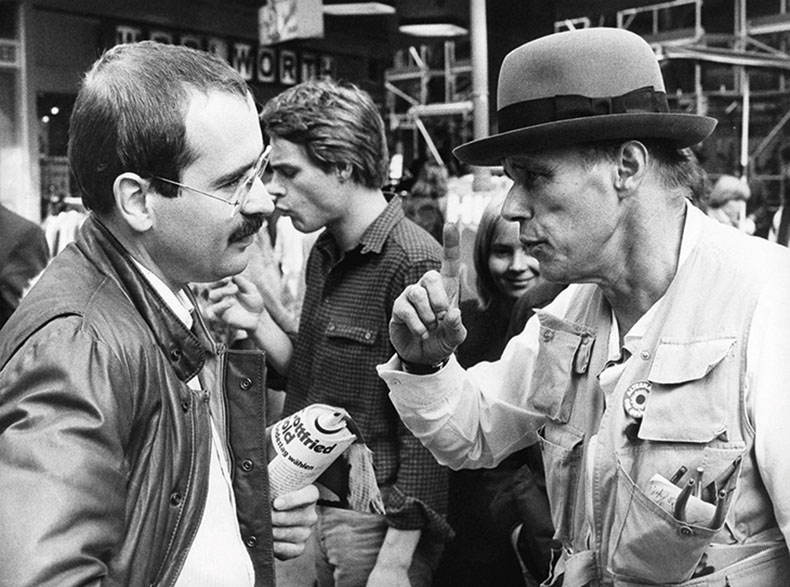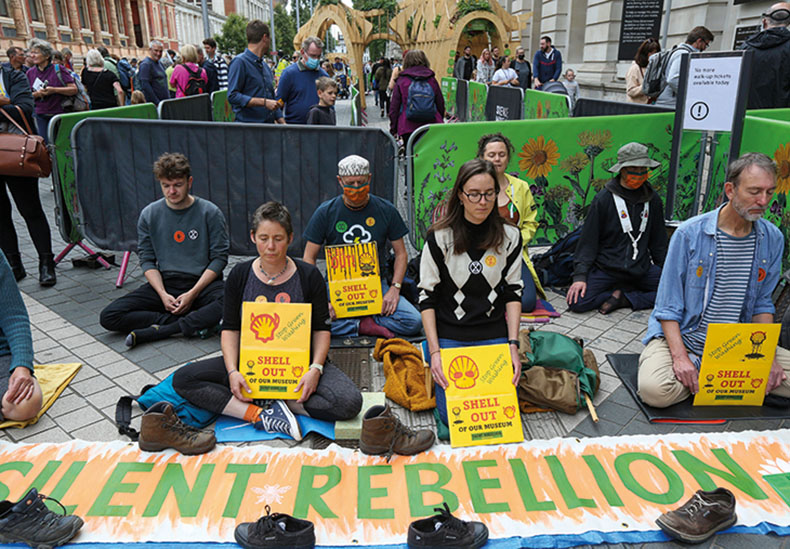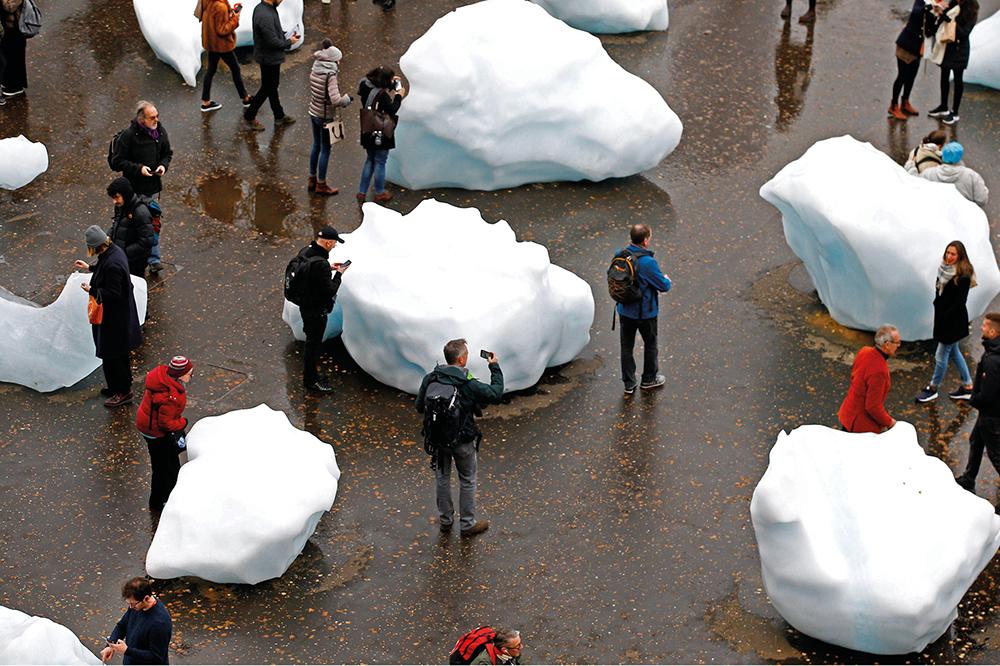From the April 2022 issue of Apollo. Preview and subscribe here.
People who work in the visual arts sector – from curators to critics and PR execs to artists – have a habit of describing it as an ecosystem. Compared with the actual communities of organisms and physical environments that populate this planet, this ecosystem is faring pretty well. Climate change is wreaking havoc on habitats around the world and the situation is only getting worse. The latest report from the Intergovernmental Panel on Climate Change (IPCC), published in February, which details impacts of a global temperature rise projected to reach at least 1.5 degrees C by 2040, was described by the UN Secretary-General as an ‘atlas of human suffering’. Following COP26 and ahead of this year’s World Earth Day on 22 April, calls for action to stem this rise have become increasingly urgent. But it’s not always clear what form this action should take.
The growing consensus among artists, museums, galleries and adjacent organisations is that they can no longer wait for governments or the big polluting industries to act, and it is their job to get things moving in the right direction. (Perhaps this isn’t surprising, given the sector’s propensity for ecologically flavoured language.) But here too there are questions about how this will be achieved.
There is certainly no lack of talk. In April 2019, after several countries declared a state of ‘climate emergency’, a group of 190 arts organisations and individuals in the UK followed suit under the banner ‘Culture Declares Emergency’. Among the first institutions to sign up were Somerset House, HOME Manchester and Jerwood Arts, soon joined by the directors of the Tate, who pledged to ‘respond with actions across all four Tate galleries, and at our stores’. In 2020, the Gallery Climate Coalition (GCC) was launched, aiming to provide sustainability guidelines for the sector in the UK and beyond. Organisations public and private have appointed sustainability leads, published carbon strategies and held conferences: just recently, the National Museum Directors’ Council organised a two-day symposium in Manchester (7–8 March) and MuseumNext convened a virtual Green Museums Summit (28–30 March).
And that’s only in the UK. A comprehensive account of the international art scene’s environmental activism would rival the IPCC’s reports in length. In the United States, for instance, the coalitions Galleries Commit and Artists Commit (launched in 2020 and 2021 respectively) are seeking to establish more ‘climate-conscious’ practices among their members. Last year, the Helen Frankenthaler Foundation inaugurated the Frankenthaler Climate Initiative, which awards millions of dollars in grants to American visual arts organisations to help improve their energy efficiency.
Joseph Beuys (right), campaigning as a candidate for the Greens during the Bundestag election of 1980. Photo: Sueddeutsche Zeitung Photo/Alamy Stock Photo

Then there are the countless anthropocene-inflected exhibitions. Artists dabbling in environmental activism is nothing new: in 1979, Joseph Beuys stood as a Green in the European Parliament elections, and since then others have undertaken land reclamation projects or initiated campaigns to reduce the global art community’s air miles. But now hardly a day goes by without an email arriving in my inbox about new works that ‘articulate environmental concerns’ or ‘offer a lament for the planet’ or ‘reclaim space for speculative thinking about our ecological future’ (to quote just three randomly selected recent press releases). Many of these don’t just talk about the crisis but try to mitigate it. The artist duo Cooking Sections, for example, have worked with museums across the UK as part of their installation and performance project ‘Becoming Climavore’, which begins by removing all farmed salmon from cafe and restaurant menus. Exhibitions with an ecological theme tend to come with a disclaimer about the use of eco-friendly materials or carbon offsetting. For a show at Tate Modern in 2021, the artists Ackroyd & Harvey even made a point of displaying only one jpeg image on the exhibition webpage – ‘to make it as low carbon as possible’.
That this conversation is getting louder is welcome. But however well-intentioned they may be, it is hard to know the impact of all these exhibitions and conferences and coalitions – to sort self-congratulatory gimmicks from less showy but more significant structural improvements.
Heath Lowndes, managing director of the GCC, tells me that ‘There is a fairly narrow range of activities that are the main emissions culprits in the art world.’ Carbon reports from the coalition’s members indicate that the main areas of concern are shipping, travel and energy – ‘moving people and objects and powering buildings, basically’. The same applies to other organisations across the visual art sector. The GCC’s recommended targets are to reduce carbon emissions by at least 50 per cent by 2030 and implement near zero-waste practices. Other organisations have set even more ambitious targets: the Tate and the V&A, which both publish their waste and emissions in annual reports, want to reach net zero by 2030 and 2035 respectively. In line with warnings from Greenpeace and others, the GCC strongly counsels against carbon offsetting to achieve this, because it is impossible to know how effectively and how quickly most available schemes will work.
It’s good that organisations are monitoring their emissions, but the reports don’t make for inspirational reading, charting modest and not always consistent progress. The V&A’s annual report for 2020–21, for instance, concedes that an ‘overall reduction in energy consumption’ for that period must ‘partly be attributed to the closure of the museum during the pandemic’ (other organisations echo this). The year before, pre-Covid, the museum reported a drop in carbon emissions of just over seven per cent – mostly thanks to new energy-efficient lighting in the galleries – but a cold autumn and problems with generators meant that gas consumption was up. The year before that, Scope 1 (direct) emissions had actually increased, owing to extended opening hours for the popular Frida Kahlo and Christian Dior exhibitions in summer 2018 and early 2019. That year wasn’t great for the Tate either, with energy use up in part due to ‘conditioning needs’ from an unusually hot summer – there are likely to be more where that came from.
We will have to wait to analyse properly the post-pandemic trajectories of institutional carbon emissions but existing data indicates that – short of shutting down all venues or carbon offsetting, which fortunately none of the museums I have spoken to are currently planning to implement – there is a limit to what these organisations can do to reach net zero before improvements are made in other sectors.
The art sector is a ‘relatively small industry’, Lowndes points out, with emissions nowhere near the scale of agriculture, for example, or even the fashion industry. Still, focused emission audits can cast some projects presented as forms of climate action in a dubious light. In 2018, for instance, the artist Olafur Eliasson commissioned the environmental NGO Julie’s Bicycle to monitor the carbon footprint of the latest iteration of his work Ice Watch, for which he transported 30 chunks of glacial ice from a fjord in Greenland to Bankside and the City in London. The stated goal was to raise awareness by offering a ‘direct and tangible experience of the reality of melting arctic ice’. Julie’s Bicycle found that the project produced the same emissions as flying 30 people to Greenland to see the fjord itself: not a huge amount, but far from net zero. It prompts the question of whether artists-cum-environmental activists ought to take a leaf from Beuys’s book and enter the political arena instead of shipping sculptures around the world.
Protestors from Extinction Rebellion staging a sit-in at the Science Museum, London, in August 2021. Photo: Martin Pope/SOPA Images/LightRocket via Getty Images

A more serious question is whether sector leaders are resisting necessary systemic changes that come with less public recognition than a splashy exhibition – especially when the status quo has a greater profit margin. The Tate’s carbon accounting, for example, shows that its energy expenditure went up in 2016–17, the year of the opening of its vaunted Blatvanik extension. (The project’s sponsor, Len Blavatnik, made his fortune in part through investments in coal and oil; there is a whole other discussion to be had about corporate greenwashing in the cultural sector. The National Portrait Gallery’s decision to end its 30-year relationship with BP indicates progress, but there is still plenty of oil money in the art world.)
The ‘traditional capitalist model of growth’, as Lowndes puts it, has long been identified as a key obstacle to effective climate action. ‘ We are moving forward generally, the awareness has absolutely been won, people know they have an impact,’ he says. But he must know that he would be laughed out of the room if he were to ask fairs to stop growing. (It’s worth noting that two members of the GCC’s founding team are Frieze co-founder Matthew Slotover and the fair’s former director Victoria Siddall.) A similar point could be made about the soaring popularity of non-fungible tokens, or NFTs, criticised for their massive carbon footprint – it is estimated that the Ethereum network on which most NFTs are minted uses more power annually than the whole of the Philippines or Belgium. And from anecdotal research and personal experience, the international art world is – for all the talk of ‘train-first’ initiatives – still racking up the air miles.
But maybe there is an upside to all the money and power that flows through this small but unusually well-connected industry. The GCC certainly thinks so: one of the main pillars of its operations is raising funds to support non-governmental organisations working on the frontline of the climate crisis: an art auction series, recently launched with Christie’s, has so far raised more than £5m for the environmental law charity ClientEarth, which has used lawsuits to block coal and gas plants. The GCC recommends that as an alternative to carbon offsetting, member organisations should establish a ‘Strategic Climate Fund’ to donate to environmental charities. There are also plans to launch a lobbying campaign focusing on the shipping industry and highlighting the environmental impact of air freight in the art sector in particular.
It is too soon to tell whether such campaigns, both within and beyond the art sector, will be able to reverse or even limit the damage from climate change. But while lobbying and fundraising may not carry as many plaudits as declaring a climate emergency or unveiling a monumental new artwork about melting ice caps, they are likely to have a long-term impact beyond the gallery walls. Perhaps, then, it’s time to give eco art a rest – and focus on work that might give us a fighting chance of leaving behind a planet where art and culture of all kinds can be enjoyed by future generations.
From the April 2022 issue of Apollo. Preview and subscribe here.



